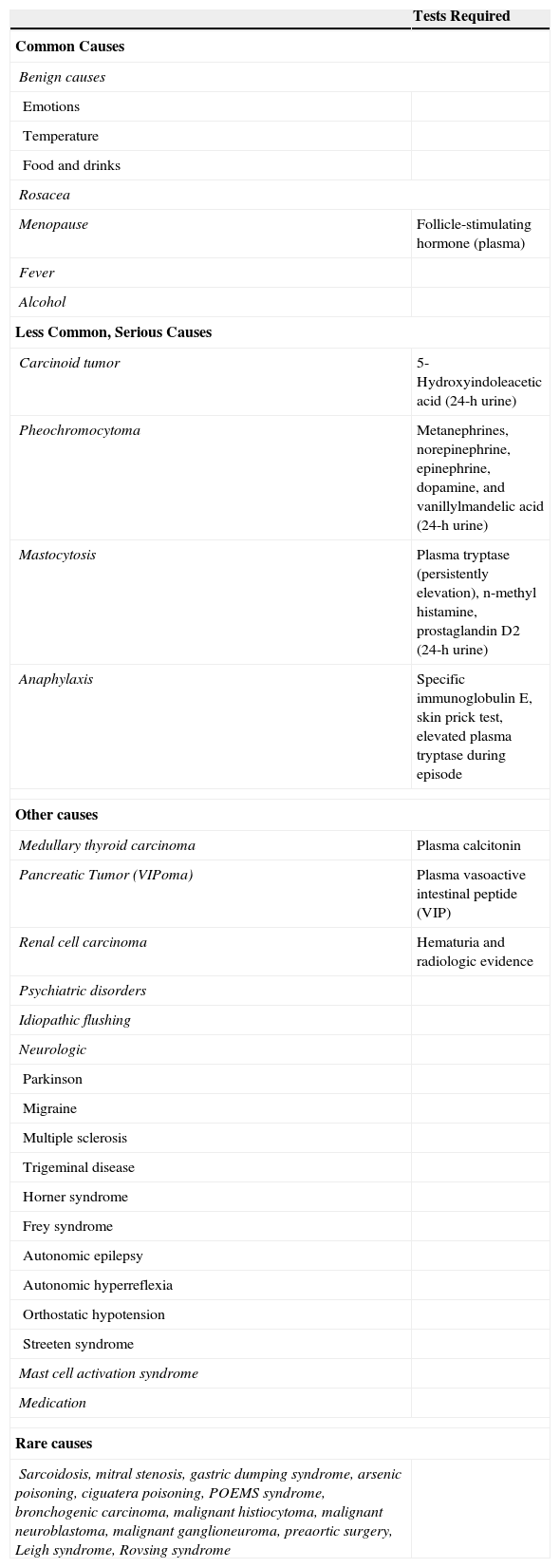Facial erythema is a very common reason for consulting a dermatologist. While often a manifestation of a benign condition, in some cases it may be the first sign of a more serious disorder and specific diagnostic tests are needed to rule out these diseases. Flushing can be produced by agents acting on the vascular smooth muscle receptors or by signals sent by the vasomotor nerves. It can be episodic or persistent. Episodic flushing is usually caused by endogenous vasoactive mediators or medication. Persistent flushing is caused by successive episodes over long periods, which eventually lead to the appearance of telangiectasias and enlarged vessels with slow-flowing deoxygenated blood.1Table 1 shows the most common benign causes of flushing as well as other less common and potentially serious causes.2 The first step is to determine whether the patient's clinical history and a careful physical examination provide sufficient information to guide the diagnosis. If they do, we only have to decide whether or not additional tests are required to confirm the suspected diagnosis. Once the diagnosis is confirmed and the cause established, we can decide on an appropriate treatment. In more complex cases, the patient should keep a diary for 2 weeks and record when flushing occurs, the symptoms, any association with other symptoms (diarrhea, bronchospasm, headache, low blood pressure, tachycardia, abdominal pain, urticaria, or pruritus), and any external triggers (food, beverages, drugs, alcohol, exercise, emotions, stress, or occupational exposure). The data collected may provide the key to a suspected diagnosis, which can then be confirmed by the appropriate diagnostic studies. When the results obtained do not point to a possible cause or when the investigations undertaken do not support the suspected diagnosis, a more comprehensive battery of tests must be ordered to rule out the more common serious causes of flushing (Table 1). The recommended first step is to measure plasma levels of serotonin, tryptase, chromogranin A, and histamine and 24h-urine levels of 5-hydroxyindoleacetic, vanillylmandelic acid, norepinephrine, metanephrines, and prostaglandin D2. In the presence of elevated values, the suspected diagnosis would be carcinoid syndrome, pheochromocytoma, or mastocytosis.3 If the results are within normal limits, we would then check for the presence of the following: hematuria, which would be indicative of renal cell carcinoma; elevated vasoactive intestinal peptide, which would suggest pancreatic carcinoma; elevated calcitonin, which would point to a possible medullary thyroid carcinoma. If an anaphylactic reaction is suspected, we would measure immunoglobulin E or perform a skin prick test for a specific substance. If the findings do not clearly support a particular diagnosis, the next step should be to investigate the less common causes, such as anxiety, psychiatric disorders, idiopathic flushing, and mast cell activation syndrome.4
Flushing: Causes and the Diagnostic Tests Required.
| Tests Required | |
|---|---|
| Common Causes | |
| Benign causes | |
| Emotions | |
| Temperature | |
| Food and drinks | |
| Rosacea | |
| Menopause | Follicle-stimulating hormone (plasma) |
| Fever | |
| Alcohol | |
| Less Common, Serious Causes | |
| Carcinoid tumor | 5-Hydroxyindoleacetic acid (24-h urine) |
| Pheochromocytoma | Metanephrines, norepinephrine, epinephrine, dopamine, and vanillylmandelic acid (24-h urine) |
| Mastocytosis | Plasma tryptase (persistently elevation), n-methyl histamine, prostaglandin D2 (24-h urine) |
| Anaphylaxis | Specific immunoglobulin E, skin prick test, elevated plasma tryptase during episode |
| Other causes | |
| Medullary thyroid carcinoma | Plasma calcitonin |
| Pancreatic Tumor (VIPoma) | Plasma vasoactive intestinal peptide (VIP) |
| Renal cell carcinoma | Hematuria and radiologic evidence |
| Psychiatric disorders | |
| Idiopathic flushing | |
| Neurologic | |
| Parkinson | |
| Migraine | |
| Multiple sclerosis | |
| Trigeminal disease | |
| Horner syndrome | |
| Frey syndrome | |
| Autonomic epilepsy | |
| Autonomic hyperreflexia | |
| Orthostatic hypotension | |
| Streeten syndrome | |
| Mast cell activation syndrome | |
| Medication | |
| Rare causes | |
| Sarcoidosis, mitral stenosis, gastric dumping syndrome, arsenic poisoning, ciguatera poisoning, POEMS syndrome, bronchogenic carcinoma, malignant histiocytoma, malignant neuroblastoma, malignant ganglioneuroma, preaortic surgery, Leigh syndrome, Rovsing syndrome | |
We currently have symptomatic treatment at our disposal: brimonidine tartrate 0.5% gel. This topical treatment, which has been shown to be safe and effective in controlled clinical trials and has recently become available in Spain, can help to control flushing and improve the patient's quality of life.5
The dermatologist plays a key role in the diagnosis of patients with flushing, since correct management may have implications for the morbidity and mortality of the condition.
Please cite this article as: Lamas-Doménech N, Collgros H. RR - Eritema facial: claves para el diagnóstico diferencial. Actas Dermosifiliogr. 2015;106:427–429.




